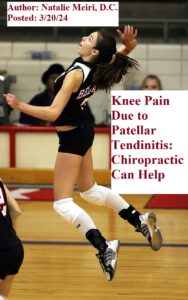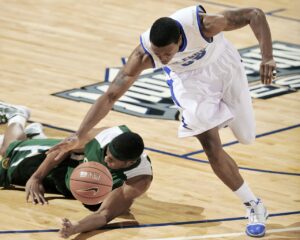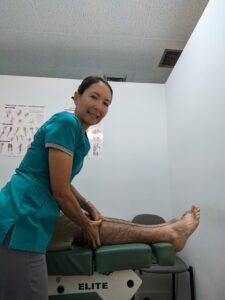
Do you have pain and tenderness around your patellar tendon or lower part of the patella (kneecap)? It may be described as a burning pain in the knee with use or after prolonged sitting with the knee flexed. Perhaps jumping, running or walking may be difficult due to the pain? Additionally, you may have swelling and erythema (redness of the skin) along the patellar tendon depending on the amount of inflammation. Also, in chronic cases a nodule of scar tissue that is often tender can be found in the tendon or near the patella. Keep reading to find out more about Knee Pain Due to Patellar Tendinitis: Chiropractic Can Help.
Knee Anatomy: Femur (thigh bone), Tibia (shin bone), Fibula (thin, outer long bone of the leg), and the Patella (kneecap)
There are three “articulations” (joint or juncture between bones or cartilages) at the knee: the tibiofemoral, patellofemoral, and tibiofibular articulations. However, only the tibiofemoral and patellofemoral articulations participate in knee joint activity. The tibiofibular articulation/joint does not actually contribute to the actions of the knee. Instead, it is part of the ankle joint complex moving the ankle in all the various ranges of motion. However, dysfunctional processes in the proximal tibiofibular articulation/joint can affect other knee functions and can be a source of knee pain.
So the tibiofemoral and tibiofibular are synovial articulations. These are freely movable joints. And the bony surfaces are coated with hyaline cartilage. It is unified by a fibrous articular capsule. However, the third articulation, patellofemoral, is a functional joint (non-synovial joint).

What is Patellar Tendinitis (Jumper’s Knee)?
Tendinitis is inflammation of the thick fibrous cords that attach muscle to bone. Jumper’s knee is a traction (pulling/microtear of knee) overuse syndrome (group of signs and symptoms). Furthermore, it can be a quadriceps (group of muscles in the front of thigh) tendinitis or patellar tendinitis. So this depends on whether the quadriceps bone-tendon junction of the superior (upper) patella or the bone-tendon junction of the inferior (lower) patella is primarily involved.
Quadriceps tendinitis is more common in the age group older than 30 years. And patella tendinitis is more common in the adolescent (10-17 years old) population. Importantly, involvement of the quadriceps in an adolescent is probably an avulsion (tearing away) of the proximal (nearer to the trunk) patellar epiphysis (growth plate) rather than an actual quadriceps tendinitis.
Cause of Patellar Tendinitis
Patellar Tendonitis is most often an overuse/ repetitive injury problem. Most of it is due to “microtearing”. Next, your body will try to repair the microtearing degenerative process that is taking place. Ultimately, this leads to increased thickness of the insertional fibrocartilage at the patella bone-tendon junction. Sadly, patients treated with steroid injections are prone to developing ruptures. In contrast, Chiropractic restores and normalizes function to joints. Therefore, the inflammation and pain subside.
Sometimes, a subtle lateral (outward) subluxation may be a case due to overloading of the patellar tendon. Moreover, tight hamstrings can produce abnormal movements when extending the knee. Lastly, tight hamstrings and patellar tendinitis were found as a cause in hard playing surfaces combined with overtraining.

4 Stages of Patellar Tendinitis
1st Stage- pain only after activity.
2nd Stage- pain at the beginning of activity that disappears after warm up and returns after activity.
3rd Stage- constant pain at rest and inability to participate in sports
4th Stage- complete rupture of the patellar tendon.
Patellar Tendonitis is not self limiting (goes away on own). Without proper treatment and with continued overuse, it may progress through the different stages described above. Even Stage 3 may sometimes be irreversible and require surgery. Therefore, it is wise to get treatment as soon as possible.
Treatment at Meiri Chiropractic for Patellar Tendinitis.
Firstly, during the acute phase, rest/ proper warm up before use, stretching, ice after use and a patella restraining brace are recommended.
Secondly, soft tissue techniques (e.g. myofascial release, cross friction) will be performed on the patella ligament and all associated muscles.
Thirdly, chiropractic adjustments (chiropractic manipulative therapy) to the Knee, patella and associated restricted joints along the kinetic chain is important.
Fourthly, therapeutic exercise will be given for stretching and strengthening. For example, hamstring and gastrocnemius and quadriceps stretching and strengthening.
Are your suffering from Knee or patellar tendon Pain?
We offer excellent Chiropractic care for Patellar Tendinitis. At Meiri Chiropractic, we spend the time necessary to examine, diagnose and treat every neuromusculoskeletal condition and various ailments you have. Indeed. chiropractic will to keep your body in its best working condition. We have been offering effective chiropractic care in West Palm Beach since 2006. Many of our patients reviews note our excellence. Call us today at 561-253-8984 to make an appointment or to find out more about Knee Pain Due to Patellar Tendinitis: Chiropractic Can Help.